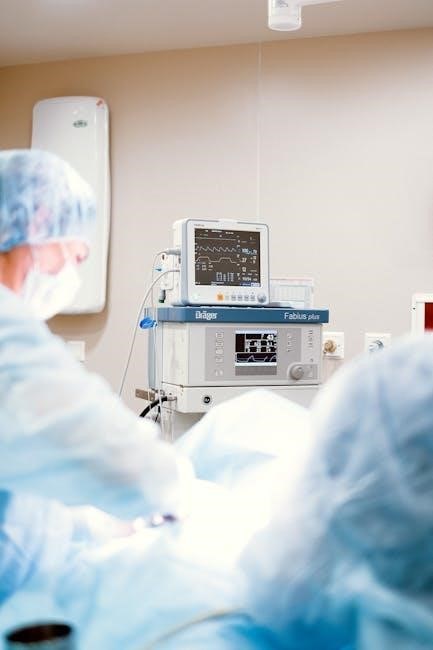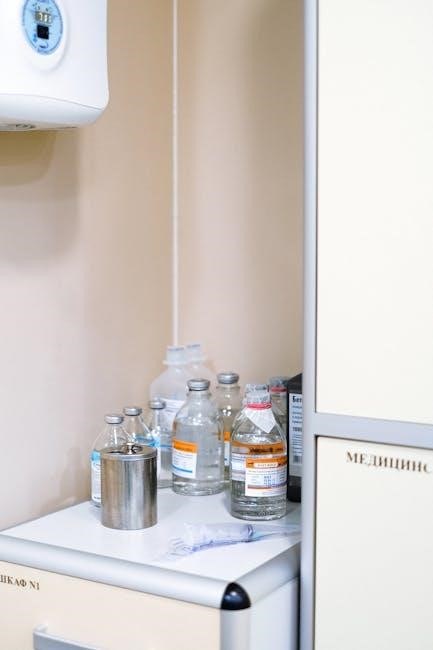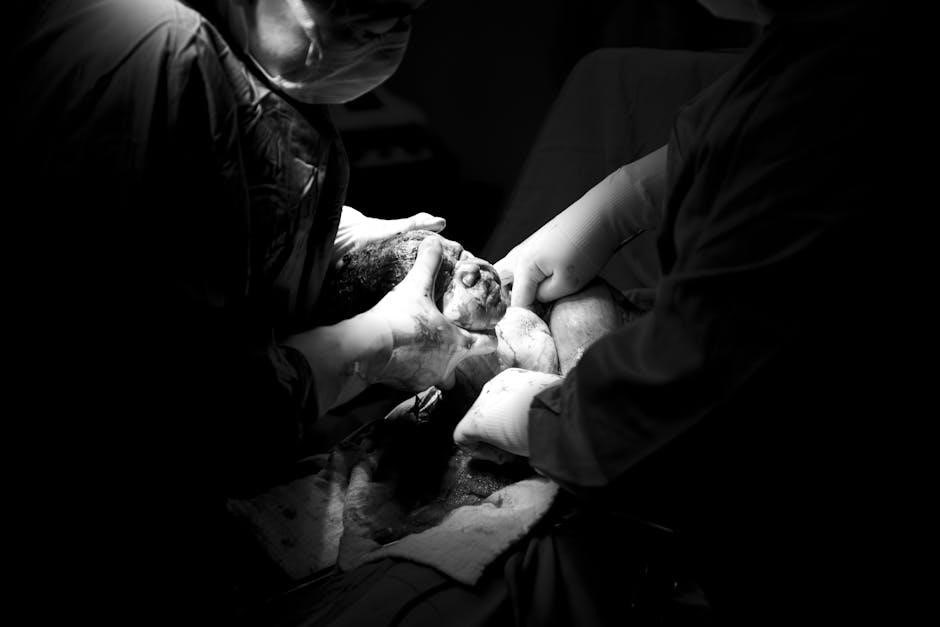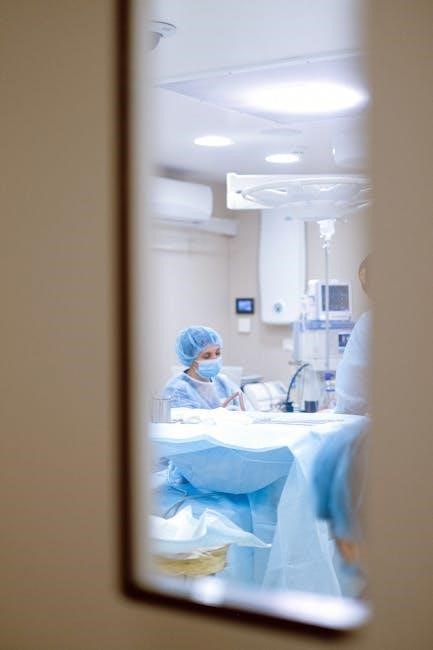
The operating room (OR) is a complex, highly controlled environment requiring precision, sterility, and seamless teamwork. It is equipped with advanced technology and instruments to ensure patient safety and optimal surgical outcomes.
1.1 Key Components of the Operating Room Setup
The operating room setup includes essential elements like the surgical table, overhead lighting, ventilation systems, and anesthesia equipment. Instrument tables, mayo stands, and suction machines are strategically placed for accessibility. Monitoring devices and emergency equipment, such as defibrillators, are also critical. The room is designed to maintain sterility, with laminar airflow systems reducing contamination risks, ensuring a safe and efficient environment for surgical procedures.
1.2 Importance of Sterility and Safety Protocols
Sterility and safety protocols are paramount in the operating room to minimize infection risks and ensure patient safety. Strict adherence to hand hygiene, surgical attire, and equipment sterilization is essential. Safety measures, such as proper use of PPE and emergency preparedness, protect both patients and staff. Maintaining a sterile environment and following established guidelines are critical to preventing complications and achieving successful surgical outcomes.
Pre-Operative Preparation
Pre-operative preparation involves thorough patient evaluation, surgical planning, and team coordination to ensure readiness for the procedure, optimizing safety and efficiency in the operating room environment.
2.1 Patient Assessment and Surgical Consent
Patient assessment involves a comprehensive evaluation of the patient’s medical history, current health status, and surgical readiness. Informed consent is obtained, ensuring the patient understands the procedure, risks, benefits, and alternatives. This process is crucial for legal compliance and patient trust, involving clear communication between the patient and surgical team to confirm agreement before proceeding with the operation.
2.2 Surgical Team Preparation and Roles
The surgical team undergoes thorough preparation, ensuring all members are ready for their roles. The surgeon leads the procedure, while the anesthesiologist manages anesthesia and patient monitoring. Surgical nurses assist with instrumentation and maintain a sterile field, and surgical technicians prepare equipment and supplies. Effective communication and coordination among team members are essential to ensure a smooth and safe operation.
Surgical Instruments and Equipment
Surgical instruments and equipment are essential tools in the OR, ranging from scalpels and forceps to anesthesia machines and surgical lights. They ensure precision and sterility.
3.1 Common Surgical Instruments and Their Uses
Surgical instruments are essential tools in the OR, designed for specific tasks. Scalpels are used for making incisions, while forceps and clamps handle tissues. Retractors expose surgical sites, and suction tubes remove fluids. Each instrument is chosen for its precision and ability to minimize trauma, ensuring optimal surgical outcomes and patient safety during procedures.
3.2 Essential Operating Room Equipment
The operating room is equipped with vital equipment to ensure safe and efficient surgical procedures. Anesthesia machines deliver precise sedation, while ventilators assist patient breathing. Electrosurgical units enable tissue cutting and cauterization. Monitoring systems, like ECG and blood pressure devices, track vital signs. Surgical lights provide optimal illumination, and warming units maintain body temperature. These tools are integral to maintaining patient safety and facilitating successful surgical outcomes.

Anesthesia in the Operating Room
Anesthesia ensures pain management and patient stability during surgery. Types include general, regional, and local anesthesia. Anesthesiologists monitor and adjust levels to maintain optimal patient safety and comfort.
4.1 Overview of Anesthesia Types
Anesthesia is categorized into general, regional, and local types. General anesthesia induces unconsciousness, regional numbs specific areas, and local anesthetizes smaller regions. Each type ensures pain management and patient safety, tailored to the surgical procedure and patient needs, allowing for precise and effective pain control during operations.
4.2 Monitoring and Safety Measures
Continuous monitoring of vital signs, such as heart rate, blood pressure, and oxygen levels, is essential during anesthesia. Advanced equipment tracks anesthesia depth to prevent awareness or complications. Emergency preparedness, including crash carts and rapid response systems, ensures timely interventions. The anesthesia team remains vigilant, adhering to strict safety protocols to minimize risks and maintain patient stability throughout the procedure.

Patient Positioning and Safety
Patient positioning ensures optimal surgical access and prevents complications. Proper techniques, supportive devices, and team coordination are crucial to maintain safety and comfort throughout the procedure.
5.1 Proper Positioning Techniques
Proper patient positioning is critical for surgical success and safety. The surgical team collaborates to ensure optimal alignment, minimizing strain on the patient. Techniques vary by procedure, but key principles include maintaining anatomical neutrality, using supportive devices like stirrups or padding, and evaluating the position before draping. Adjustments are made to prevent pressure points and ensure proper circulation. Clear communication and careful planning are essential to achieve the desired position while protecting the patient’s well-being. This ensures both surgical access and patient comfort, reducing the risk of complications and promoting recovery. Proper positioning is a foundational aspect of perioperative care, requiring precision and attention to detail to meet the needs of both the patient and the surgical team.
5.2 Preventing Complications Related to Positioning
Preventing complications from patient positioning involves meticulous planning and monitoring. Regular assessments ensure proper alignment, reducing nerve and circulatory risks. Supportive devices, like pads or cushions, minimize pressure points. Monitoring for signs of ischemia or neuropathy is essential. Maintaining open communication among the surgical team and documenting positioning details can help identify and address potential issues promptly, ensuring patient safety and optimal surgical outcomes.

Surgical Team Communication
Surgical team communication is critical for ensuring clear, concise, and timely information exchange. It involves active listening, precise language, and mutual respect to maintain patient safety and efficiency.
6.1 Effective Communication Strategies
Effective communication in the OR involves clear, concise verbal exchanges and active listening. Use standardized terminology to avoid ambiguity. Non-verbal cues, such as hand signals, enhance coordination. Assign a designated communicator to relay critical information, ensuring all team members are informed; Regular time-outs to confirm plans and verify instruments or supplies are essential. Technology, like headset systems, can also facilitate real-time communication, maintaining workflow and patient safety.
6.2 Role of the Surgical Team in Ensuring Patient Safety
The surgical team plays a pivotal role in maintaining patient safety through clear responsibilities and collaboration. Surgeons focus on precise technique, while anesthesiologists monitor vital signs and pain management. Nurses ensure instrument sterility, count supplies, and maintain a safe environment. Technicians manage equipment functionality. Each member adheres to protocols, communicates effectively, and remains vigilant for potential risks, fostering a culture of safety and accountability to protect the patient throughout the procedure.

Infection Control and Sterilization
Infection control is critical in the OR. Protocols include sterilizing instruments, using autoclaves, and enforcing PPE to minimize contamination risks and ensure a safe surgical environment.
7.1 Protocols for Maintaining a Sterile Environment
Maintaining sterility in the OR involves strict adherence to protocols such as proper hand hygiene, wearing surgical attire, and using sterile supplies. All instruments are sterilized using autoclaves or chemical methods. The OR is cleaned and disinfected before each procedure, and only authorized personnel are allowed entry to prevent contamination. These measures ensure patient safety and reduce infection risks during surgery.
7.2 Proper Use of PPE in the OR
Proper use of PPE is critical to prevent infection transmission and ensure patient and staff safety. Surgical masks, gloves, gowns, and eye protection must be worn correctly. Masks cover the nose and mouth, gloves prevent skin contact with bodily fluids, and gowns protect clothing. PPE should be donned before entering the sterile field and removed carefully to avoid contamination. Training ensures compliance with infection control protocols.

Emergency Preparedness
Effective emergency preparedness ensures rapid response to critical situations in the OR. Protocols for crises like cardiac arrests or fire hazards are essential to maintain patient and staff safety.
8.1 Common Emergencies in the OR
Common OR emergencies include anesthesia complications, massive bleeding, cardiac arrest, and equipment malfunctions. These situations require immediate attention to prevent patient harm. Proper training, clear communication, and readily available emergency equipment are crucial for effective crisis management. Regular drills ensure the surgical team is prepared to handle such incidents efficiently, maintaining patient safety and operational continuity.
8.2 Crisis Management and Response
Effective crisis management in the OR relies on structured protocols, clear communication, and predefined roles. Immediate action plans, emergency checklists, and readily available equipment ensure prompt responses. Surgical teams must remain calm, prioritize patient safety, and coordinate efforts seamlessly. Regular emergency drills and debriefings enhance preparedness, enabling the team to adapt and improve their response strategies for critical situations.
Post-Operative Care
Post-operative care focuses on monitoring recovery, managing pain, and preventing complications. Close observation in the recovery room ensures patient stability before transferring to the ward or discharge.
9.1 Immediate Post-Surgical Recovery
Immediate post-surgical recovery occurs in the post-anesthesia care unit (PACU), where vital signs are closely monitored. Patients are assessed for pain, nausea, and complications like bleeding or respiratory issues. The goal is to ensure stability, manage discomfort, and prevent adverse reactions before transferring the patient to the hospital ward or preparing for discharge.
9.2 Discharge Planning and Patient Education
Effective discharge planning ensures a smooth transition for patients post-surgery. Nurses provide detailed instructions on medication, wound care, and follow-up appointments. Patient education focuses on recognizing signs of complications, managing pain, and promoting recovery. Clear communication and written guidelines help patients and caregivers adhere to post-operative instructions, reducing readmissions and improving outcomes.

Continuous Improvement in OR Practices
Continuous improvement in OR practices involves regular debriefing, feedback, and training to enhance efficiency, safety, and patient outcomes through ongoing education and innovation.
10.1 Importance of Debriefing and Feedback
Debriefing and feedback are crucial for identifying areas of improvement and enhancing OR efficiency. These practices foster open communication, allow team members to reflect on their performance, and help refine surgical techniques. Regular feedback loops ensure continuous learning, improve patient safety, and promote a culture of accountability and excellence within the surgical team.
10.2 Role of Training and Simulation
Training and simulation are vital for enhancing surgical teams’ technical and decision-making skills. Simulation-based training allows practitioners to practice complex procedures in a controlled environment, reducing errors and improving patient safety. These tools also foster teamwork and crisis management skills, enabling OR staff to adapt to new technologies and procedures efficiently, ensuring optimal surgical outcomes and continuous improvement in OR practices.
Future of Operating Room Technology
The future of the operating room lies in advanced technologies like AI, robotics, and augmented reality, enhancing surgical precision, streamlining processes, and improving patient outcomes significantly.
11.1 Emerging Technologies in Surgery
Emerging technologies like AI, robotics, and augmented reality are revolutionizing surgery, offering enhanced precision and minimizing human error. AI-driven systems analyze data to optimize surgical plans, while robotic-assisted tools enable intricate procedures with greater accuracy.
These innovations improve patient outcomes, reduce recovery times, and pave the way for personalized surgical care.
11.2 Impact of AI and Robotics in the OR
AI and robotics significantly enhance surgical precision, enabling minimally invasive procedures. Robotic systems like the da Vinci Surgical System allow surgeons to perform complex operations with reduced human error.
AI algorithms analyze real-time data to improve decision-making, predict complications, and streamline workflows, ultimately improving patient safety and recovery times.